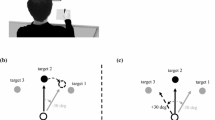Abstract
Motor adaptation is impaired by the performance of a secondary task which divides cognitive resources. Additionally, we previously reported slowed adaptation when participants were required to switch from one visual displacement adaptation task to another. Here, we examined whether a dividing secondary task had a similar effect on adaptation as switching between opposing visual displacements. The resource-dividing task involved simultaneously adapting to a step-visual displacement whilst vocally shadowing an auditory stimulus. The switching task required participants to adapt to opposing visual displacements in an alternating manner with the left and right hands. We found that both manipulations had a detrimental effect on adaptation rate. We then integrated these tasks and found the combination caused a greater decrease in adaptation rate than either manipulation in isolation. A second set of experiments showed that adaptation to a gradually imposed visual displacement was influenced in a similar manner to step adaptation. In summary, step adaptation slows the learning rate of gradual adaptation to a large degree, whereas gradual adaptation only slightly slows the learning rate of step adaptation. Therefore, although gradual adaptation involves minimal awareness it can still be disrupted with a cognitively demanding secondary task. We propose that awareness and cognitive resource can be regarded as qualitatively different, but that awareness may be a marker of the amount of resource required. For example, large errors are both noticed and require substantial cognitive resource. However, a lack of awareness does not mean an adaptation task will be resistant to interference from a resource-consuming secondary task.





Similar content being viewed by others
References
Bock O, Worringham C, Thomas M (2005) Concurrent adaptations of left and right arms to opposite visual distortions. Exp Brain Res 162(4):513–519
Criscimagna-Hemminger SE, Donchin O, Gazzaniga MS, Shadmehr R (2003) Learned dynamics of reaching movements generalize from dominant to nondominant arm. J Neurophysiol 89:168–176
Diedrichsen J, Hashambhoy Y, Rane T, Shadmehr R (2005) Neural correlates of reach errors. J Neurosci 25:9919–9931
Donchin O, Francis JT, Shadmehr R (2003) Quantifying generalization from trial-by-trial behavior of adaptive systems that learn with basis functions: theory and experiments in human motor control. J Neurosci 23:9032–9045
Eversheim U, Bock O (2001) Evidence for processing stages in skill acquisition: a dual-task study. Learn Mem 8(4):183–189
Galea JM, Miall RC (2006) Concurrent adaptation to opposing visual displacements during an alternating movement. Exp Brain Res 175:676–688
Hadipour-Niktarash A, Lee CK, Desmond JE, Shadmehr R (2007) Impairment of retention but not acquisition of a visuomotor skill through time-dependent disruption of primary motor cortex. J Neurosci 27(49):13413–13419
Hwang EJ, Smith MA, Shadmehr R (2006) Dissociable effects of the implicit and explicit memory systems on learning control of reaching. Exp Brain Res 173:425–437
Ingram HA, van Donkelaar P, Cole J, Vercher JL, Gauthier GM, Miall RC (2000) The role of proprioception and attention in a visuomotor adaptation task. Exp Brain Res 132(1):114–126
Klassen J, Tong C, Flanagan J (2005) Learning and recall of incremental kinematic and dynamic sensorimotor transformations. Exp Brain Res 164:250–259
Malfait N, Ostry DJ (2004) Is interlimb transfer of force-field adaptation a cognitive response to the sudden introduction of load? J Neurosci 24:8084–8089
Mazzoni P, Krakauer JW (2006) An implicit plan overrides an explicit strategy during visuomotor adaptation. J Neurosci 26(14):3642–3645
Oldfield RC (1971) The assessment and analysis of handiness: the Edinburgh inventory. Neuropsychologia 9:97–113
Sainburg RL, Wang JS (2002) Interlimb transfer of visuomotor rotations: independence of direction and final position information. Exp Brain Res 145:437–447
Slachevsky A, Pillon B, Fourneret P, Pradat-Diehl P, Jeannerod M, Dubois B (2001) Preserved adjustment but impaired awareness in a sensory–motor conflict following prefrontal lesions. J Cogn Neurosci 13(3):332–340
Smith MA, Ghazizadeh A, Shadmehr R (2006) Interacting adaptive processes with different timescales underlie short-term motor learning. PLoS Biol 4:1035–1043
Taylor JA, Thoroughman KA (2007) Divided attention impairs human motor adaptation but not feedback control. J Neurophysiol 98(1):317–326
Thoroughman KA, Shadmehr R (2000) Learning of action through adaptive combination of motor primitives. Nature 407(6805):742–747
Tseng YW, Diedrichsen J, Krakauer JW, Shadmehr R, Bastian AJ (2007) Sensory prediction errors drive cerebellum-dependent adaptation of reaching. J Neurophysiol 98(1):54–62
Vangheluwe S, Wenderoth N, Swinnen SP (2005) Learning and transfer of an ipsilateral coordination task: evidence for a dual-layer movement representation. J Cogn Neurosci 17:1460–1470
Acknowledgments
We thank Jonathan Winter and Steve Caulder for technical assistance. This work was supported by a grant from the Wellcome trust and an EPSRC studentship.
Author information
Authors and Affiliations
Corresponding author
Rights and permissions
About this article
Cite this article
Galea, J.M., Sami, S.A., Albert, N.B. et al. Secondary tasks impair adaptation to step- and gradual-visual displacements. Exp Brain Res 202, 473–484 (2010). https://doi.org/10.1007/s00221-010-2158-x
Received:
Accepted:
Published:
Issue Date:
DOI: https://doi.org/10.1007/s00221-010-2158-x




